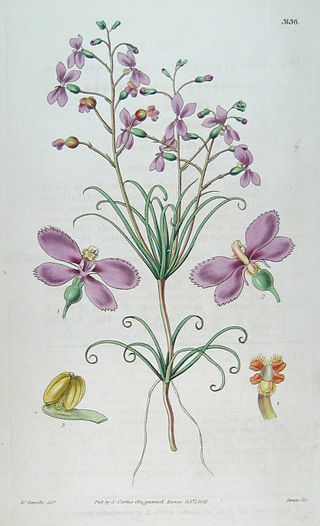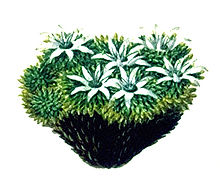
Asterales is an order of dicotyledonous flowering plants that includes the large family Asteraceae known for composite flowers made of florets, and ten families related to the Asteraceae. While asterids in general are characterized by fused petals, composite flowers consisting of many florets create the false appearance of separate petals.

The Araliaceae are a family of flowering plants composed of about 43 genera and around 1500 species consisting of primarily woody plants and some herbaceous plants commonly called the ginseng family. The morphology of Araliaceae varies widely, but it is predominantly distinguishable based on its woody habit, tropical distribution, and the presence of simple umbels.

Hamamelidaceae, commonly referred to as the witch-hazel family, is a family of flowering plants in the order Saxifragales. The clade consists of shrubs and small trees positioned within the woody clade of the core Saxifragales. An earlier system, the Cronquist system, recognized Hamamelidaceae in the Hamamelidales order.

The Primulaceae, commonly known as the primrose family, are a family of herbaceous and woody flowering plants including some favourite garden plants and wildflowers. Most are perennial though some species, such as scarlet pimpernel, are annuals.

Asphodeloideae is a subfamily of the monocot family Asphodelaceae in the order Asparagales. It has previously been treated as a separate family, Asphodelaceae sensu stricto. The family Asphodelaceae has now been proposed to be a nomen conservandum, and the proposal has been recommended for ratification in 2017. In that case, Asphodelaceae will have priority over Xanthorrhoeaceae. This is reflected in the APG IV family lists.

Asphodelaceae is a family of flowering plants in the order Asparagales. Such a family has been recognized by most taxonomists, but the circumscription has varied widely. In its current circumscription in the APG IV system, it includes about 40 genera and 900 known species. The type genus is Asphodelus.

Gelsemiaceae is a family of flowering plants, belonging to the order Gentianales. The family contains only three genera: Gelsemium, Mostuea and Pteleocarpa. Gelsemium has three species, one native to Southeast Asia and southern China and two native to Central America, Mexico, and the southeastern United States. The eight species of Mostuea are native to tropical areas of South America, Africa, and Madagascar. The two genera were formerly classified in the family Loganiaceae. Pteleocarpa was originally placed in Boraginaceae or in its own family Pteleocarpaceae, but it is most closely related to Gelsemiaceae with which it shares significant characters.

Peridiscaceae is a family of flowering plants in the order Saxifragales. Four genera comprise this family: Medusandra, Soyauxia, Peridiscus, and Whittonia., with a total of 12 known species. It has a disjunct distribution, with Peridiscus occurring in Venezuela and northern Brazil, Whittonia in Guyana, Medusandra in Cameroon, and Soyauxia in tropical West Africa. Whittonia is possibly extinct, being known from only one specimen collected below Kaieteur Falls in Guyana. In 2006, archeologists attempted to rediscover it, however, it proved unsuccessful.

Theophrastoideae is a small subfamily of flowering plants in the family Primulaceae. It was formerly recognized as a separate family Theophrastaceae. As previously circumscribed, the family consisted of eight genera and 95 species of trees or shrubs, native to tropical regions of the Americas.

The family Stylidiaceae is a taxon of dicotyledonous flowering plants. It consists of five genera with over 240 species, most of which are endemic to Australia and New Zealand. Members of Stylidiaceae are typically grass-like herbs or small shrubs and can be perennials or annuals. Most species are free standing or self-supporting, though a few can be climbing or scrambling.

Escalloniaceae is a family of flowering plants consisting of about 130 species in seven genera. In the APG II system it is one of eight families in the euasterids II clade (campanulids) that are unplaced as to order. More recent research has provided evidence that two of those families, Eremosynaceae and Tribelaceae, arose from within Escalloniaceae; the Angiosperm Phylogeny Website therefore merges these two families into Escalloniaceae, and also places the family alone in order Escalloniales.
Pentaphylax is a genus of flowering plants, with one or two species which are shrubs and small trees. The species has simple evergreen leaves that are alternately arranged on the stems. The flower pistil is 5 celled and the anthers dehiscing via pores and basifixed. Flowers have five petals and five sepals that are distinct from each other and five stamens attached oppositely to the sepals. The seeds are winged.

Tolypangium is a subgenus of the genus Stylidium that is characterized by ovoid to longish capsules. This subgenus was part of the earliest taxonomic division among the triggerplants. Stephan Ladislaus Endlicher first split the genus into two subgenera in 1838: Tolypangium with its ovoid capsules and Nitrangium with its linear capsules. Subsequent authors generally followed this classification, which is based almost entirely on the features of the capsule. Recent genetic analysis, combined with an exhaustive morphological comparison, has revealed that the classification defined by Johannes Mildbraed in 1908 is not the most accurate description of how the members of different subgenera and sections are related. As part of the Flora of Australia series, Juliet Wege will be reviewing and updating the taxonomy of the Stylidiaceae.

Verticillatae is a section in the subgenus Tolypangium that is characterized by globose capsules. Recent genetic analysis, combined with an exhaustive morphological comparison, has revealed that the classification defined by Johannes Mildbraed in 1908 is not the most accurate description of how the members of different subgenera and sections are related. As part of the Flora of Australia series, Juliet Wege will be reviewing and updating the taxonomy of the Stylidiaceae.

Forstera is a genus of small perennial plants in the Stylidiaceae family named in honour of the German naturalists Johann Reinhold Forster and his son, Georg Forster, who had previously described Forstera's sister genus, Phyllachne just five years earlier. It comprises five species that are endemic to New Zealand with the exception of F. bellidifolia, which is endemic to Tasmania. The species in this genus resemble those in a subgenus of the related genus Stylidium called Forsteropsis, but they are more closely related to the genus Phyllachne. Proposals to merge the two genera based on information from cladistic analysis have emerged because of these genera's morphological similarities and evidence that they are paraphyletic.

Forstera bellidifolia, the Tasmanian forstera, is a species in the family Stylidiaceae that is endemic to Tasmania, Australia. It was described by William Jackson Hooker in an 1851 volume of Icones Plantarum. It is notably different from other members of the genus in that it is not native to New Zealand nor does it possess the epigynous nectaries that are present in the other species.

Donatia novae-zelandiae is a species of mat-forming cushion plant, found only in New Zealand and Tasmania. Common names can include New Zealand Cushion or Snow Cushion, however Snow Cushion also refers to Iberis sempervirens. Donatia novae-zelandiae forms dense spirals of thick, leathery leaves, creating a hardy plant that typically exists in alpine and subalpine bioclimatic zones.

The taxonomy of the plant family Liliaceae has had a complex history since its first description in the mid-eighteenth century. Originally, the Liliaceae were defined as having a "calix" (perianth) of six equal-coloured parts, six stamens, a single style, and a superior, three-chambered (trilocular) ovary turning into a capsule fruit at maturity. The taxonomic circumscription of the family Liliaceae progressively expanded until it became the largest plant family and also extremely diverse, being somewhat arbitrarily defined as all species of plants with six tepals and a superior ovary. It eventually came to encompass about 300 genera and 4,500 species, and was thus a "catch-all" and hence paraphyletic. Only since the more modern taxonomic systems developed by the Angiosperm Phylogeny Group (APG) and based on phylogenetic principles, has it been possible to identify the many separate taxonomic groupings within the original family and redistribute them, leaving a relatively small core as the modern family Liliaceae, with fifteen genera and 600 species.
Birgitta Bremer, Swedish botanist and academic, is professor at Stockholm University, and director of the Bergius Botanic Garden.

Donatia fascicularis is a species of cushion plant in the family Donatiaceae and is closely related to species in the family Stylidiaceae. It is found in the alpine and subalpine regions of western Patagonia and Tierra del Fuego. It is the type species of the genus Donatia J.R. Forst. & G. Forst.


















